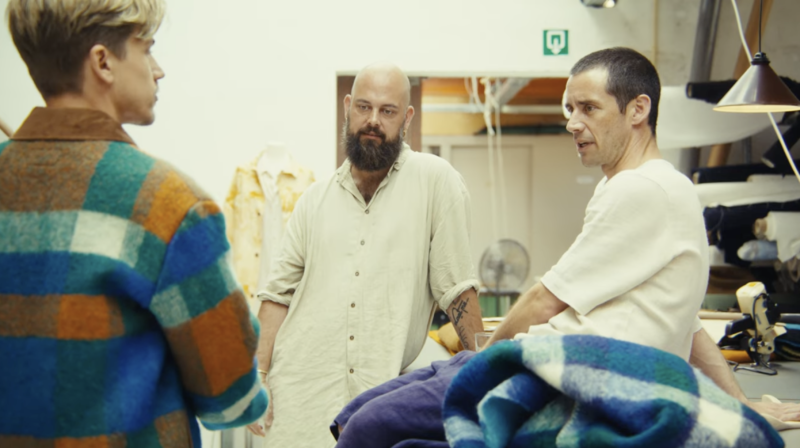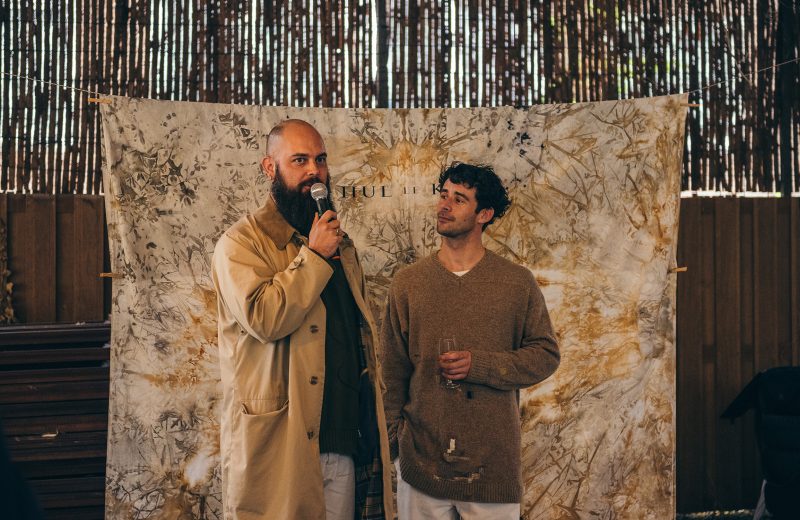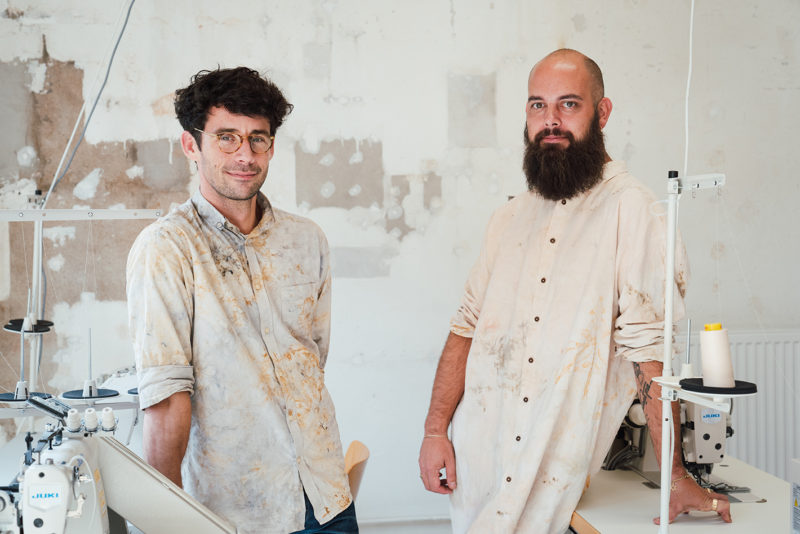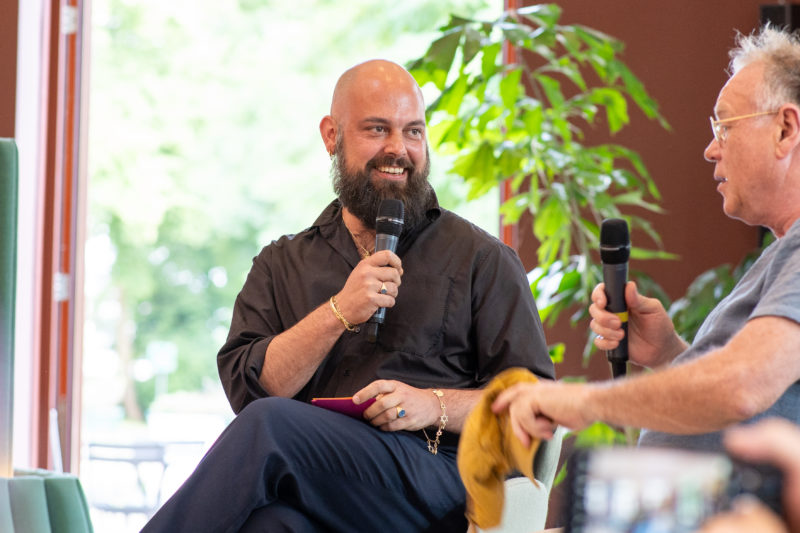This week, Hul le Kes celebrates the 40th birthday of our Managing Director and co-founder, Sebastiaan Kramer. In honor of this milestone, we take a moment to look at our company through Sebastiaan’s eyes. Sebastiaan has been pivotal in shaping Hul le Kes’ identity, from its early conceptual days to its current role as a leading force in circular and socially driven fashion. His unique blend of business insight and emotional intelligence has guided our growth in a way that’s as purposeful as it is human. To mark the occasion, we asked Sebastiaan ten questions about his journey and his vision for Hul le Kes.
Sjaak and I both studied Fashion Design at ArtEZ University of the Arts in Arnhem. Towards the end of our studies, we discovered a shared passion for fashion, and for each other. After graduation, we began working together professionally and personally. While the nature of our romantic relationship has evolved over time, our professional collaboration has remained strong and full of love.
Before founding Hul le Kes, we ran a menswear label with stores in Arnhem and The Hague, where we sold many tailored suits. However, despite our success, it didn’t bring us true fulfillment. We returned to the drawing board to reflect on what fashion truly meant to us and how we could offer a viable alternative to the existing system. That’s how Hul le Kes came to life; with our Manufacturing Studio, Recovery Studio, flagship store in Arnhem, online shop, and international stockists.

My main role at Hul le Kes is to maintain balance between our social, circular, commercial and artistic ambitions. Unlike most companies, Hul le Kes operates from a truly holistic perspective. It’s a fascinating way to work (if I may say so) but it also presents complexities. I constantly need to ensure that the various, sometimes conflicting, goals of our business stay in harmony.
I also believe the strength of Hul le Kes lies in the intrinsic motivation of everyone who works with us. That’s why it’s crucial to listen to input from all team members. Our leadership style may not be the fastest route to profit, but it remains rooted in ethics and takes people, nature, and community into account. That, to me, is what makes a brand truly relevant today; it’s where our real impact lies.
There are many aspects I feel proud of when I look at where Hul le Kes stands today. Each new stockist brings a sense of achievement, a happy customer in our store fills me with joy, and every new design feels like a small triumph. Yet what makes me most proud is seeing someone flourish through their journey at the Hul le Kes Recovery Studio.
Some individuals begin their time with us at a point where their self-confidence has all but disappeared. Witnessing them rediscover belief in themselves (and, through that, a renewed appreciation for the world) is indescribably moving. No revenue milestone or circular business model compares to the pride I feel when our team helps someone rekindle that inner light. It’s what makes Hul le Kes tangible and profoundly human.

The biggest issue is that everything in the current fashion system (and, in fact, the world at large) is measured by financial metrics. Profit margins, growth, and speed dominate all decision-making. This model is fundamentally egocentric and hierarchical, and it reflects a broader inability among humans to truly live together; it often feels like we’re being taught to survive, not coexist.
Short-term thinking drives the fashion industry, with no regard for future generations. What the world needs now is a courageous shift to long-term vision. That kind of thinking requires stepping beyond one’s ego and fears. We need that mindset not just in fashion, but in every part of society if we are to create meaningful change.
For me, that’s embroidery and mending clothes. In fact, the idea for the Hul le Kes Recovery Studio was born from this personal habit. Whenever my mind becomes overwhelmed with ideas, stress, or emotion, I turn to handwork as a form of self-regulation. When Sjaak expressed his desire to bring his background in social work into our business, the pieces fell into place.
We researched the mental health benefits of handcrafting, and my intuition was scientifically validated. Additionally, our mission to reuse textiles for as long as possible aligned perfectly. Everything came together like a puzzle. To this day, you’ll find me embroidering on the couch when I need mental clarity; though never at the studio, where my focus is needed elsewhere.
I hope we’ll be able to support even more people through our Recovery Studio, perhaps even expanding with locations outside Arnhem. I also dream of giving more discarded textiles a second, third, or even fourth life through upcycling. To achieve that, we’ll need broader reach and more dedicated supporters who understand that we are much more than just another brand.
If we can grow in that way and continue contributing to a better world, I will feel truly fulfilled. But what must never be lost is the balance between our social, circular, artistic, and commercial values. Only by maintaining that equilibrium can we continue to exist and make a positive impact on both people and the planet.

That every person has the capacity to contribute meaningfully to society. Burnouts, anxiety disorders, depression; these challenges can affect anyone. Sjaak and I have always believed that Hul le Kes should be a place for people of all backgrounds: culturally, educationally, and generationally diverse.
Alongside the mentors at the Recovery Studio, we strive to create a microcosm of society where everyone learns from one another, especially in moments of vulnerability. I’ve also learned that love is essential. Too often, people haven’t received the love they deserve. At Hul le Kes, we aim to offer a little extra care, so that individuals can rediscover pride in themselves.
Once again, it’s all about balance: this time, within our collections. From the very start, we’ve aimed to design gender-fluid clothing that accommodates a variety of body types. That’s not always easy, nor always commercially advantageous, and not every garment lends itself to this approach. But we maintain balance across the entire collection to make it work.
While our designs are limited in number, the use of unique, reclaimed materials ensures that no two items are ever the same. Each fabric reacts differently, offering a distinct expression. In spring next year, we’ll be shifting our approach slightly to make our clothing more accessible to a broader audience through expanded price points. How we’ll do that remains a surprise, I’d say: subscribe to our newsletter to be among the first to know!
From the day we opened our first store in Arnhem with our previous label, I’ve been dedicated to strengthening the city’s fashion and design scene. I founded the Arnhemse Stockdagen, later passed it on, and became Creative Director of the Fashion + Design Festival Arnhem. I’ve served on design boards, led sustainability research, and advocated for the creative industry in the region.
Now, as a curator at Museum Arnhem, I continue that mission in a new way. I believe it’s vital to keep fashion alive and vibrant in Arnhem. On a personal level, I thrive on variety. Especially now, since I’ve taken a deep dive into the world of Contemporary Jewelry as well, through my role as a curator of Body-Related Design. I’ve never been one to focus on just a single role. The diversity of my work keeps me inspired and challenged, and that, in turn, fuels everything I do.

Phew… I graduated from art school at 19 and jumped straight into my career. From the age of eight, I knew I wanted to be a designer, and I did everything I could to make that happen as quickly as possible. Looking back, I wonder: why the rush? I wish I had taken more time to savor the experiences I had, especially in my twenties.
It wasn’t until I turned 30 that I began to truly understand what I was doing. Reflection has never been my strong suit, and I’m rarely satisfied with myself. So if I had advice for my younger self, it would be this: pause now and then to appreciate what you’ve achieved. And honestly, that’s still advice I need to remind myself of today.
Sebastiaan’s story reflects the spirit that drives Hul le Kes: a belief in connection, in imperfection, in creating beauty with purpose. As we celebrate his 40th birthday, we’re reminded of how far we’ve come and how much possibility lies ahead. Thank you, Sebastiaan, for your vision and integrity. Here’s to the next chapter. Check out our Instagram and other social media channels for more insides from Sebastiaan this week.
Main picture’s credits: Anne Timmer for Vogue Living